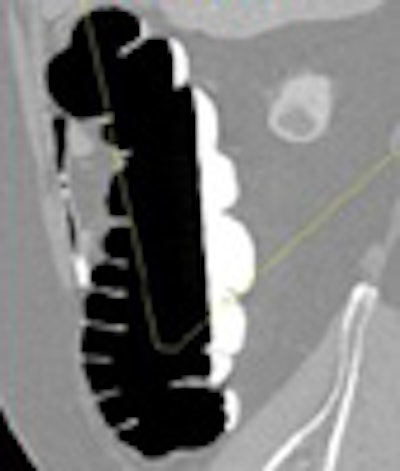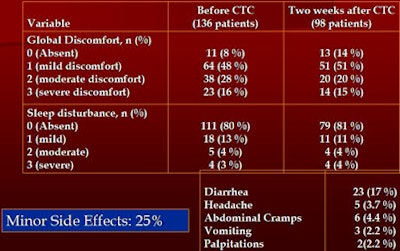
CHICAGO - A virtual colonoscopy preparation consisting only of iodinated oral contrast got high marks for ease of use from the elderly, compared to cathartic bowel prep and failed optical colonoscopy that preceded the scans, in a new study from Italy. Significant findings at VC made the procedure worth the effort, researchers reported Tuesday.
While researchers look for better ways to screen for colorectal cancer, the demographic clock is ticking away in the industrialized world. Each year the population, most of which has never been screened, is growing older.
"It has been estimated that by 2020, 132 million in Europe will be aged more than 65, and in the U.S. elderly people will account for 16% of the population," said Dr. Franco Iafrate from the University of Rome "La Sapienza," in a presentation at the RSNA 2007 meeting.
The screening needs of the elderly are different from those of the healthy 50-somethings who have been the traditional target of colon screening efforts. The tests must be gentler, and the bar for intervention is higher when lesions are detected. Small polyps detected at CT colonography (CTC) are left alone. "We are looking only for masses larger than 10 mm or polypoid lesions," Iafrate told AuntMinnie.com.
Virtual colonoscopy is clearly indicated in the case of failed colonoscopy, which can occur in up to 40% of patients.
In study population, the most common causes of failed colonoscopy were redundant colon in 46% (n = 63) of patients and diverticular disease in 40% (n = 54), Iafrate said. Two patients had obstructing masses. The most common stop point for conventional colonoscopy was the sigmoid colon and, as a result, 492 of 816 potentially visible colonic segments were not examined.
"We wanted to evaluate in how many patients we could find lesions in the proximal colon," he said.
The study examined 132 patients (64 men, 72 women; age 70-92, mean age 81) with incomplete optical colonoscopy, along with four frail patients who had not been examined previously.
Subjects were excluded if they had a history of familial adenomatous polyposis or hereditary nonpolyposis cancer syndrome, prior colorectal surgey, or a suspected bowel obstruction, Iafrate said.
For two days before scanning, the subjects ate a low-fiber diet and ingested 180 mL of the oral iodinated tagging agent diatrizoate meglumine (Gastrografin, Bayer Schering Pharma, Berlin), along with 2 L of water in the afternoon. The tagging agent has a mild cathartic effect, but no actual laxatives were administered before scanning, and an antiperistaltic agent (Buscopan, Boehringer Ingelheim, Ingelheim, Germany) was used in only 21 patients.
Images were acquired on a 64-slice scanner (LightSpeed VCT, GE Healthcare, Chalfont St. Giles, U.K.) at 100 mAs and 120 kVp. Collimation was 0.625 mm, and images were reconstructed at a slice thickness of 1 mm.
Prone and supine scans were acquired except for nine patients who were scanned in the supine position only due to mobility issues, including a paraplegic patient.
Virtual colonoscopy was successful in all 136 patients and detected additional lesions in the proximal colon in 14% of the cohort. "We found four primary carcinomas and nine polypoid lesions in eight patients, and three lipomas," Iafrate said. One patient had a large mesenteric liposarcoma.
A questionnaire was administered to patients to determine their subjective experience on the bowel preparation. The questionnaire consisted of separated scale drawn between no side effects and discomfort and severe side effects and discomfort. The prep was rated good overall. There were no major side effects, and 25% reported minor side effects such as diarrhea (n = 14).
 |
| Mild side effects were reported in 25% of patients with the use of diatrizoate meglumine iodinated tagging agent. All images courtesy of Dr. Franco Iafrate. |
A similar study performed in the elderly two years ago with a wet polyethylene glycol prep found much lower patient acceptance, Iafrate said, adding that the two studies were not formally compared.
"CTC has an undeniable role in elderly and frail patients in whom conventional colonoscopy is difficult to fully perform," Iafrate concluded. "In our experience, no major side effects were observed, and it's an easier and much confortable preparation for the patient."
By Eric Barnes
AuntMinnie.com staff writer
November 27, 2007
Related Reading
VC in elderly patients yields extracolonic advantage, November 7, 2007
Extracolonic findings double VC costs, but might be worth paying, July 20, 2006
Tagged VC succeeds where colonoscopy fails in elderly, March 28, 2006
Iodine tagging regimen yields best VC results, January 27, 2005
Screening colonoscopy worthwhile into the eighth and ninth decades, September 1, 2003
Copyright © 2007 AuntMinnie.com




















